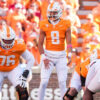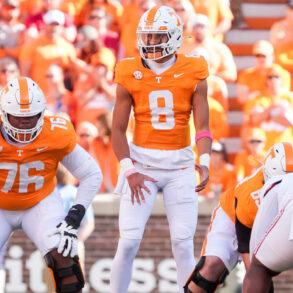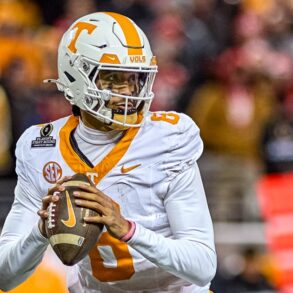A team will now be charged a timeout if a player goes down injured after the ball is spotted for play. (Photo by David J. Griffin/Icon Sportswire via Getty Images)
(Icon Sportswire via Getty Images)
The NCAA has approved changes designed to prevent players from going down with an injury to slow down offenses playing at a fast tempo.
Starting in 2025, a team will be charged a timeout if its training staff enters the field to look at a player who has gone down after the ball was spotted for the next play. If a player goes down after the ball is spotted and his team doesn’t have any timeouts remaining, his team will be assessed a five-yard delay of game penalty.
“The injury timeout proposal was made by the NCAA Football Rules Committee after many in the college football community raised concerns about strategies in which players fake an injury to stop the opposition’s momentum or to avoid using an allotted timeout,” an NCAA statement late Wednesday night said.
“This has been a topic of discussion for the NCAA Football Rules Committee in recent years. Before the 2021 season, a framework was instituted that allows a school or conference to request a postgame video review headed by Steve Shaw, the NCAA secretary-rules editor/national coordinator of officials, regarding questionable actions involving injuries.”
Advertisement
In 2024, conferences could be notified if it was determined that a player faked an injury and the conference had the right to punish the school. During the second half of the season, SEC commissioner Greg Sankey sent a memo to his conference’s teams imploring them to stop faking injuries.
Overtime timeout changes
Teams will no longer get one timeout per overtime period if a game goes to a third overtime. Teams will still get one timeout for each of the first two overtimes, but if a game heads to the 2-point conversion shootout starting in the third overtime, each team will have one timeout to use for however long the game lasts.
The reduction in timeouts following the second overtime is a logical step. With teams still getting one timeout per period as they went back-and-forth with 2-point conversions, a third or fourth overtime could go timeout, play, timeout, play before the game would be over or continue to another overtime.
The Dan Lanning rule
The NCAA has also clarified further changes to the 12th-man penalty for defenses after Oregon used the rulebook to its advantage against Ohio State.
Advertisement
The Ducks called timeout and added a 12th player to its defense on third down with 10 seconds to go in its regular-season win over the Buckeyes in October. Ohio State threw an incomplete pass on the play but lost five seconds and still faced a third down after the five-yard penalty for the infraction.
The NCAA issued a rare in-season rule change after the game and said that offenses would have the ability to have the time added back to the clock if the defense committed a 12-man penalty and all 12 players were actively involved in the play.
That change will continue into 2025. If the 12th man is attempting to get off the field before the play, the time won’t be added back on, but the defense will still be penalized five yards.
This post was originally published on this site be sure to check out more of their content.







